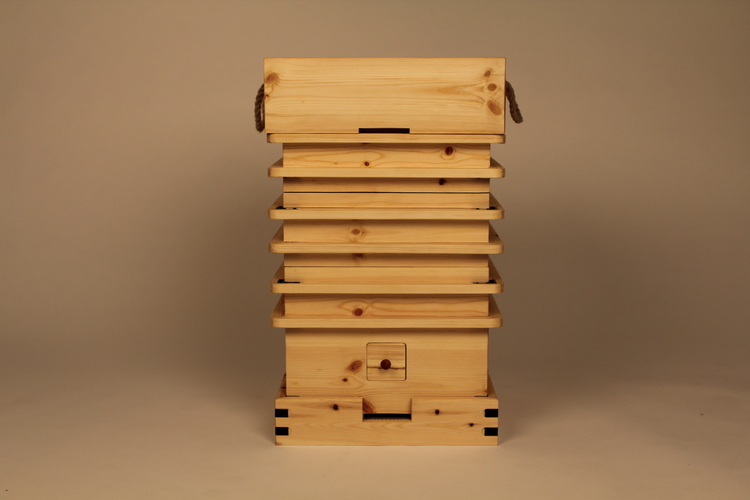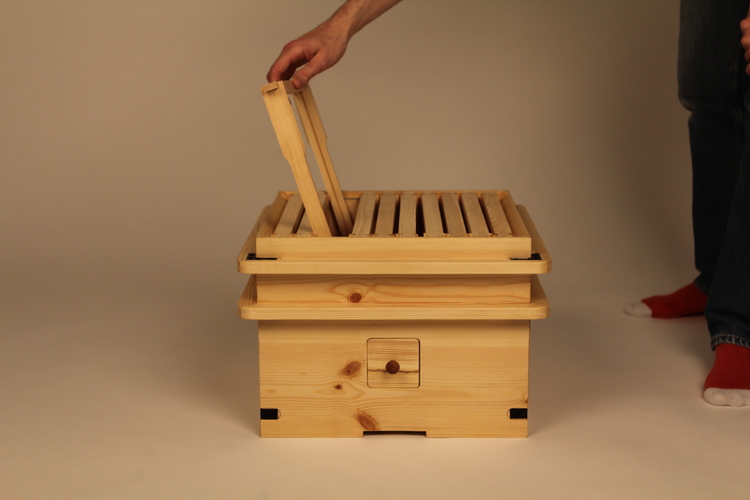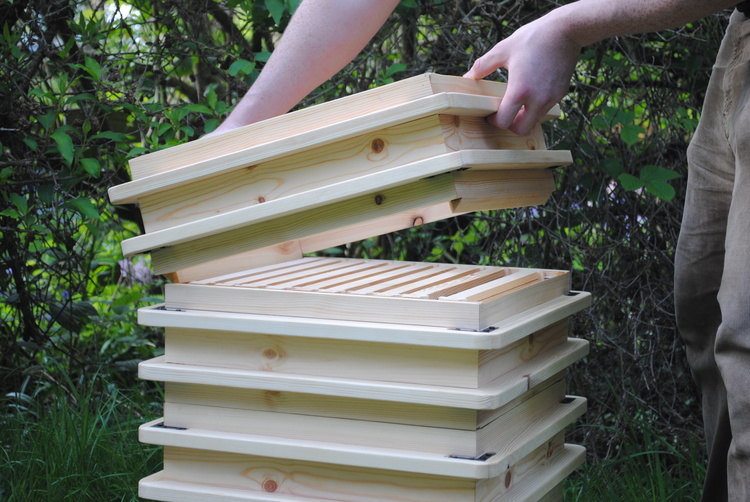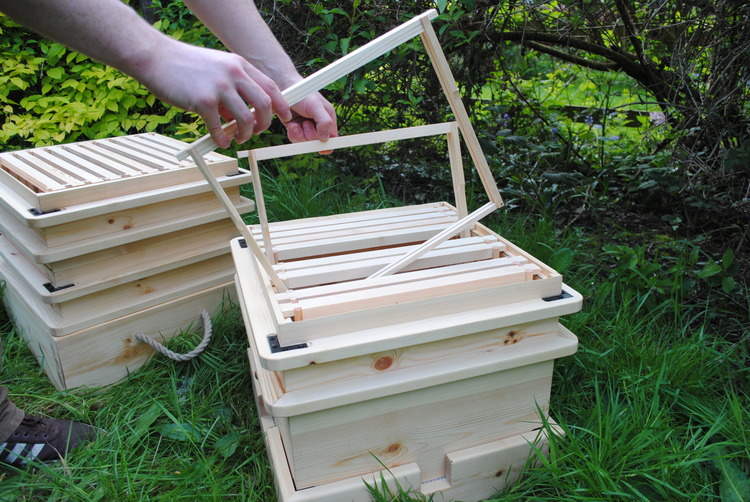Good Afternoon everyone,
Despite bumbling around on here anonymously for the past few months, I'm a new profile and I'm still not entirely sure what the forum etiquette is regarding new posters. Assuming this post is okay, I'd like to ask for the help and advice of the Beekeeping Forum collective..
My name is Jon Steven and I have recently completed my final year of BA 3D Design and Furniture at the University of Northumbria. My design work is heavily influenced by my passion and fascination for the natural world. The use of eco-friendly materials and processes has always been of importance to me but until recently, this has only ever been in the context of furniture-based projects. However, in my last project I shifted focus, creating an eco-friendly and affordable beehive in the hopes that it could contribute to the re-stabilisation of the bee population.

"The Pine Hive has been moulded from an analysis of existing products, advice from professional beekeepers, the natural world and most importantly, the Bee itself. With the same internal dimensions as the National Hive, the Pine Hive allows an interchangeability of pre existing parts such as frames and mesh floors, thus reducing waste from any potential upgrades. The hive also features an open mesh varroa mite tray held in a base that uses a simple design, allowing the hive to be turned either way to increase or decrease the entrance space in alignment with the seasons/age of the colony. An observation panel is set into the pine front of the brood box and the roof features a rubber-based flower bed with drainage holes that can be lifted using a set of soft hemp rope handles. The grips on the outer edges allow for ergonomic movement with each box slotting neatly into place atop the next thanks to an efficient 45° angle cut into two parallel panels per box. The theory of 'bee space' has been incorporated into the design meaning that all negative space is between 6mm and 10mm, thus reducing the chances of a build up of propolis or filler wax. The flower bed encourages people to not only add to bee population but to increase the amount of flowers and vegetation in the chosen environment, also giving the colony it’s own private supply of harvestable nectar. Realistically, the close proximity of this flowerbed limits it's usefulness for the bess, but it adds an element of organic customisation that will hopefully appease the keeper. The lightly-treated pine gives the product a natural aesthetic, allowing it to be incorporated into any green environment whilst the subtle confidence of the product gives the hive the ability to camouflage itself within any chosen environment, urban or rural, yet still flow with and enhance its surroundings."
Materials: Pine, Stainless Steel (brackets, mesh), Hemp (handles), Perspex (observation window)
Dimensions: H765mm x W480mm x D480mm

I firmly believe that the extortionate costs of the majority of beekeeping equipment is a swift deterrent for the average working person and in the interest of both bees and humanity, this needs to change. This brings me on to my main reason joining the Beekeeping Forum. At this point in time, I have a working prototype (more of which can be seen at: www.purplewax.co.uk) but I now wish to speak to as many beekeepers as possible and get feedback on the functionality, aesthetics, potential problems and any other aspects that you feel may help me push this project on further. I am completely open to friendly advice, industry offers, offers on a personal level, potential collaborations and anything else that you feel might contribute to the cause. Whilst I realise that realistically, I do need to make money to actually push my ideas onwards, I would just like to mention that the main aim of this project isn't about making money, but rather to bridge the financial gap between the average working person and the joys of beekeeping, as well as doing my bit for the global bee population.
At the moment, my future plans for the hive design include:
- Changing the material from pine as despite the affordability it brings to the build, it decreases the durability and longevity of the product. Also, the appearance isn't quite as pleasant as it would be had I used Iroko, Western Red Cedar or something similar. I also found that during the build, the pine would warp in the ridiculous summer heat of the workshop. This is something that could be fixed by monitoring the temperature of the build space but I would rather just re-think the material. However, any changes to material would directly impact the overall cost which is an important factor of the my design. I guess with a low-cost hive, the customer must also accept that with the money they save, it might only last 10 or so years (with an annual re-coating). As I would be aiming the pine version at the beginner-beekeepers, this does not present too much of a problem but if there are any suggestions of potential materials then that would be much appreciated!
- Angling the ridges down slightly to avoid water pooling and instead give it a place to run down from.
- Adding an inspection tray - pretty straight forward!
- The most difficulty I had during the research part of the build was when it came to choosing the finish. I searched the beekeeping forums and found lots and lots of opinions, but many contradicting each other. In the end I got a bit lost and chose Linseed oil as it seemed to have cropped up the most. If there are any other recommendations that you think I might not have considered, then that would also be hugely helpful.
- I would also like to get a general response on whether or not you think the aesthetics (form, not material) of the hive might look good in a more luxurious, yet still sustainable wood. A darker, hardwood perhaps that could then be sold to the more experienced beekeeper at a slightly higher cost, but with the added benefit that it would last a lot longer.
The design of the 'Pine Hive' is my own creation but I could not have done it without the patient assistance of Ian Wallace, a prominent beekeeping figure in the North East. I entered the beekeeping world as a designer with a pipe dream but no real knowledge of bees, beekeeping or the limitations one has to work to in designing for a living (and very picky) creature. Ian graciously enlightened me about the complexities of the bee and then provided me with the information I needed to make a start on the design process. I have compiled one booklet of the research I collected throughout the journey and another booklet that served as my own evaluation of the end-product. You can read them both here:
http://issuu.com/jonsteven/docs/bee_book_print
http://issuu.com/jonsteven/docs/beevaluation
For more information on myself, the Pine Hive and my other designs, please feel free to go to:
www.purplewax.co.uk
or email me at:
[email protected]
All the best, and I really look forward to speaking to you all!
Jon
ps. I feel like it's worth mentioning that I am now without my uni workshop space (anybody with any information on finding another one would instantly go down in my good books) but I feel like I've put so much work into this, and believe in the idea so much that I will make it happen at some point - even if its a slow process whilst I work primarily on other things.
Despite bumbling around on here anonymously for the past few months, I'm a new profile and I'm still not entirely sure what the forum etiquette is regarding new posters. Assuming this post is okay, I'd like to ask for the help and advice of the Beekeeping Forum collective..
My name is Jon Steven and I have recently completed my final year of BA 3D Design and Furniture at the University of Northumbria. My design work is heavily influenced by my passion and fascination for the natural world. The use of eco-friendly materials and processes has always been of importance to me but until recently, this has only ever been in the context of furniture-based projects. However, in my last project I shifted focus, creating an eco-friendly and affordable beehive in the hopes that it could contribute to the re-stabilisation of the bee population.

"The Pine Hive has been moulded from an analysis of existing products, advice from professional beekeepers, the natural world and most importantly, the Bee itself. With the same internal dimensions as the National Hive, the Pine Hive allows an interchangeability of pre existing parts such as frames and mesh floors, thus reducing waste from any potential upgrades. The hive also features an open mesh varroa mite tray held in a base that uses a simple design, allowing the hive to be turned either way to increase or decrease the entrance space in alignment with the seasons/age of the colony. An observation panel is set into the pine front of the brood box and the roof features a rubber-based flower bed with drainage holes that can be lifted using a set of soft hemp rope handles. The grips on the outer edges allow for ergonomic movement with each box slotting neatly into place atop the next thanks to an efficient 45° angle cut into two parallel panels per box. The theory of 'bee space' has been incorporated into the design meaning that all negative space is between 6mm and 10mm, thus reducing the chances of a build up of propolis or filler wax. The flower bed encourages people to not only add to bee population but to increase the amount of flowers and vegetation in the chosen environment, also giving the colony it’s own private supply of harvestable nectar. Realistically, the close proximity of this flowerbed limits it's usefulness for the bess, but it adds an element of organic customisation that will hopefully appease the keeper. The lightly-treated pine gives the product a natural aesthetic, allowing it to be incorporated into any green environment whilst the subtle confidence of the product gives the hive the ability to camouflage itself within any chosen environment, urban or rural, yet still flow with and enhance its surroundings."
Materials: Pine, Stainless Steel (brackets, mesh), Hemp (handles), Perspex (observation window)
Dimensions: H765mm x W480mm x D480mm

I firmly believe that the extortionate costs of the majority of beekeeping equipment is a swift deterrent for the average working person and in the interest of both bees and humanity, this needs to change. This brings me on to my main reason joining the Beekeeping Forum. At this point in time, I have a working prototype (more of which can be seen at: www.purplewax.co.uk) but I now wish to speak to as many beekeepers as possible and get feedback on the functionality, aesthetics, potential problems and any other aspects that you feel may help me push this project on further. I am completely open to friendly advice, industry offers, offers on a personal level, potential collaborations and anything else that you feel might contribute to the cause. Whilst I realise that realistically, I do need to make money to actually push my ideas onwards, I would just like to mention that the main aim of this project isn't about making money, but rather to bridge the financial gap between the average working person and the joys of beekeeping, as well as doing my bit for the global bee population.
At the moment, my future plans for the hive design include:
- Changing the material from pine as despite the affordability it brings to the build, it decreases the durability and longevity of the product. Also, the appearance isn't quite as pleasant as it would be had I used Iroko, Western Red Cedar or something similar. I also found that during the build, the pine would warp in the ridiculous summer heat of the workshop. This is something that could be fixed by monitoring the temperature of the build space but I would rather just re-think the material. However, any changes to material would directly impact the overall cost which is an important factor of the my design. I guess with a low-cost hive, the customer must also accept that with the money they save, it might only last 10 or so years (with an annual re-coating). As I would be aiming the pine version at the beginner-beekeepers, this does not present too much of a problem but if there are any suggestions of potential materials then that would be much appreciated!
- Angling the ridges down slightly to avoid water pooling and instead give it a place to run down from.
- Adding an inspection tray - pretty straight forward!
- The most difficulty I had during the research part of the build was when it came to choosing the finish. I searched the beekeeping forums and found lots and lots of opinions, but many contradicting each other. In the end I got a bit lost and chose Linseed oil as it seemed to have cropped up the most. If there are any other recommendations that you think I might not have considered, then that would also be hugely helpful.
- I would also like to get a general response on whether or not you think the aesthetics (form, not material) of the hive might look good in a more luxurious, yet still sustainable wood. A darker, hardwood perhaps that could then be sold to the more experienced beekeeper at a slightly higher cost, but with the added benefit that it would last a lot longer.
The design of the 'Pine Hive' is my own creation but I could not have done it without the patient assistance of Ian Wallace, a prominent beekeeping figure in the North East. I entered the beekeeping world as a designer with a pipe dream but no real knowledge of bees, beekeeping or the limitations one has to work to in designing for a living (and very picky) creature. Ian graciously enlightened me about the complexities of the bee and then provided me with the information I needed to make a start on the design process. I have compiled one booklet of the research I collected throughout the journey and another booklet that served as my own evaluation of the end-product. You can read them both here:
http://issuu.com/jonsteven/docs/bee_book_print
http://issuu.com/jonsteven/docs/beevaluation
For more information on myself, the Pine Hive and my other designs, please feel free to go to:
www.purplewax.co.uk
or email me at:
[email protected]
All the best, and I really look forward to speaking to you all!
Jon
ps. I feel like it's worth mentioning that I am now without my uni workshop space (anybody with any information on finding another one would instantly go down in my good books) but I feel like I've put so much work into this, and believe in the idea so much that I will make it happen at some point - even if its a slow process whilst I work primarily on other things.






